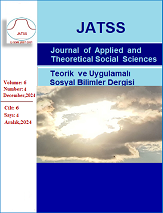Adam Smith’ten John Stuart Mill’e: Klasik İktisatta Denge Arayışı
Özet
Giriş: Bu çalışma, Klasik İktisatta denge kavramının Adam Smith’ten John Stuart Mill’e uzanan süreçte nasıl şekillendiğini incelemektedir. Bu konu; piyasa rekabeti, üretim ve bölüşüm üzerine kurulan temel fikirlerin günümüz iktisadî teorileri ve politikaları için hâlâ yol gösterici olması bakımından önemlidir.
Yöntem: Çalışmada, literatür taraması ve teorik analiz yöntemine dayalı olarak yürütülmüş; Klasik İktisatçıların eserlerinin yanı sıra bu iktisatçıların çalışmaları ve düşünceleriyle ilgili akademik çalışmalar ve yorumlar kullanılmıştır.
Sonuçlar ya da Bulgular: Yapılan analiz, Smith ve Say’in piyasa mekanizmasına duydukları güvenin, Malthus ve Ricardo’nun işaret ettiği potansiyel dengesizlikler ve durağan durum teziyle önemli ölçüde sınırlandığını ortaya koymuştur. Mill’in yaklaşımı, ekonominin uzun dönem dengesinin hem gelir dağılımı hem de toplumsal normlar tarafından etkilendiğini ve kısa dönemde ise piyasa aktörlerinin yanlış öngörüye ya da bilgiye dayalı eylemlerinin dengesizlikle sonuçlanabileceğini göstermiştir.
Tartışma ya da Yapılan Çıkarımlar: Sonuçlar, Klasik İktisadın kendi içinde farklı denge anlayışları barındırdığını ve uzun dönem eğilimlerin yanı sıra kısa dönemde ortaya çıkan dengesizliklerin önemine işaret etmektedir. Bu zengin bakış açısı, günümüz iktisadında büyüme, sürdürülebilirlik ve politika müdahaleleri konusundaki tartışmaları beslemeye devam etmektedir. Gelecekteki çalışmalar, klasik denge yaklaşımını modern kuramsal modellerle karşılaştırarak, tarihsel fikirlerin bugünkü iktisat politikalarına nasıl yön verdiğini daha derinlemesine inceleyebilir.
##plugins.generic.paperbuzz.metrics##
Referanslar
Akbay, O. S. (2009). Hume’un uluslararası ticarette otomatik akım mekanizması yaklaşımının toplumsal ve felsefi temelleri. Dumlupınar Üniversitesi Sosyal Bilimler Dergisi, 23, 1-6.
Aronoff, D. (2016). The Malthus-Ricardo debate on general glut and secular stagnation. In A Theory of Accumulation and Secular Stagnation: A Malthusian approach to understanding a contemporary malaise (pp. 10-43), Palgrave Pivot. https://doi.org/10.1057/9781137562210_2
Balassa, B. A. (1959). John Stuart Mill and the law of markets. The Quarterly Journal of Economics, 73(2), 263-274. https://doi.org/10.2307/1883724
Bannock, G., Baxter, R. E., & Davis E. (1987) Classical economics. In The Penguin dictionary of economics (4th ed., pp. 70-72), Penguin Books.
Baumol, W. J. (1999). Retrospectives: Say's law. Journal of Economic Perspectives, 13(1), 195-204. https://doi.org/10.1257/jep.13.1.195
Béraud, A., & Numa, G. (2019). Retrospectives Lord Keynes and Mr. Say: A proximity of ideas. Journal of Economic Perspectives, 33(3), 228-242. https://doi.org/10.1257/jep.33.3.228
Bladen, V. W. (1949). John Stuart Mill’s principles: A centenary estimate. The American Economic Review, 39(3), 2–12. http://www.jstor.org/stable/1831728
Blaug, M. (1997). Say’s Law of Markets: What did it mean and why should we care? Eastern Economic Journal, 23(2), 231–235. http://www.jstor.org/stable/40325773
Brue, S. L. (1993). Retrospectives: The law of diminishing returns. Journal of Economic Perspectives, 7(3), 185-192. https://doi.org/10.1257/jep.7.3.185
Canterbery, E. R. (1995). The literate economist: A brief history of economics. HarperCollins College Publishers.
Carlyle, T. (1849). Occasional discourse on the negro question. Fraser’s Magazine, 40(240), 670–679.
Chandra, R. (2004). Adam Smith and competitive equilibrium. Evolutionary and Institutional Economics Review, 1(1), 57-83. https://doi.org/10.14441/eier.1.57
Claire, O. S. (2013). A key to Ricardo. Routledge.
Clower, R. W. (2004). Trashing J.B. Say: The story of a mare’s nest. In K. V. Velupillai (Ed.), Macroeconomic Theory and Economic Policy (pp. 101-110). Routledge.
Dillard, D. (1953). Ricardo in retrospect. The Journal of Economic History, 13(1), 94-101. https://doi.org/10.1017/S002205070007008X
Dixon, R. (2006). Carlyle, Malthus and Sismondi: The origins of Carlyle’s dismal view of political economy. History of Economics Review, 44(1), 32–38. https://doi.org/10.1080/18386318.2006.11681227
Dorfman, R. (1989). Thomas Robert Malthus and David Ricardo. Journal of Economic Perspectives, 3(3), 153-164. http://doi.org/10.1257/jep.3.3.153
Evans Jr, G. H. (1967). The law of demand—The roles of Gregory King and Charles Davenant. The Quarterly Journal of Economics, 81(3), 483-492. https://doi.org/10.2307/1884813
Fernández-Villaverde, J. (2001, December 16). Was Malthus right? Economic growth and population dynamics (PIER Working Paper No.01-046). Penn Institute for Economic Research. http://dx.doi.org/10.2139/ssrn.293800
Hume, D. (1752). Political discourses. R. Fleming.
Jonsson, P. O. (1995). On the economics of Say and Keynes’ interpretation of Say’s Law. Eastern Economic Journal, 21(2), 147–155. http://www.jstor.org/stable/40325627
Kates, S. (1997). On the true meaning of Say’s Law. Eastern Economic Journal, 23(2), 191–202. http://www.jstor.org/stable/40325770
Kazgan, G. (2014). İktisadi düşünce veya politik iktisadın evrimi. On dokuzuncu basım. Remzi Kitabevi.
Kurer, O. (1989). John Stuart Mill on government intervention. History of Political Thought, 10(3), 457–480. http://www.jstor.org/stable/44797145
Levy, M. B. (1981). Mill’s Stationary State & the Transcendance of Liberalism. Polity, 14(2), 273–293. https://doi.org/10.2307/3234548
Madsen, J. B., Robertson, P. E., & Ye, L. (2019). Malthus was right: Explaining a millennium of stagnation. European Economic Review, 118, 51-68. https://doi.org/10.1016/j.euroecorev.2019.05.004
Malthus, T. R. (1798). An essay on the principle of population, as it affects the future improvement of society, with remarks on the speculations of Mr. Godwin, M. Condorcet, and other writers. 1st edition. J. Johnson. https://oll.libertyfund.org/titles/malthus-an-essay-on-the-principle-of-population-1798-1st-ed
Malthus, T. R. (1989). Principles of political economy. Cambridge University Press. (Original work published 1820)
Malthus, T. R. (2018). An essay on the principle of population: The 1803 edition. Yale University Press. (Original work published 1803)
McGee, R. W. (1989). The economic thought of David Hume. Hume Studies, 15(1), 184-204. https://doi.org/10.1353/hms.2011.0475
Mill, J. S. (1909). Principles of Political Economy with some of their Applications to Social Philosophy, 7th ed., ed. William James Ashley, Longmans, Green and Co. (Original first edition published 1848) https://oll.libertyfund.org/titles/mill-principles-of-political-economy-ashley-ed
Myers, M. L. (1976). Adam Smith’s concept of equilibrium. Journal of Economic Issues, 10(3), 560-575. https://doi.org/10.1080/00213624.1976.11503361
O’Connor, M. (1997). John Stuart Mill’s utilitarianism and the social ethics of sustainable development. The European Journal of the History of Economic Thought, 4(3), 478–506. https://doi.org/10.1080/10427719700000063
O'Leary, J. J. (1942). Malthus and Keynes. Journal of Political Economy, 50(6), 901-919. https://doi.org/10.1086/255968
Otteson, J. (2018). The essential Adam Smith. Fraser Institute.
Pancoast, O. (1943). Malthus versus Ricardo: the effects of distribution on production. Political Science Quarterly, 58(1), 47-66. https://doi.org/10.2307/2144427
Pullen, J. M. (2001). Keynes’s Criticisms of Malthus, and ‘Malthus’s Reply’: the Concept of Effective Supply, History of Economics Review, 34(1), 168-181. https://doi.org/10.1080/10370196.2001.11733364
Rankin, S. C. (1980). Supply and demand in Ricardian price theory: a re-interpretation. Oxford Economic Papers, 32(2), 241-262. https://doi.org/10.1093/oxfordjournals.oep.a041478
Ricardo, D. (2001). The principles of political economy and taxation, Batoche Books. (Original work published 1817)
Robbins (1967) Malthus as an economist. The Economic Journal, 77(306), 256–261. https://doi.org/10.2307/2229303
Savaş, V. F. (2000). İktisatın Tarihi. 4. Baskı. Siyasal Yayınevi.
Sharp, P., Strulik, H., & Weisdorf, J. (2012). The determinants of income in a Malthusian equilibrium. Journal of Development Economics, 97(1), 112-117. https://doi.org/10.1016/j.jdeveco.2010.12.004
Skinner, A. S. (1967). Say's law: Origins and content. Economica, 34(134), 153-166. https://doi.org/10.2307/2552481
Skousen, M. (2022). The making of modern economics: The lives and ideas of great thinkers. (4th ed.). Routledge.
Smith, A. (2010). The theory of moral sentiments. Penguin. (Original work published 1759)
Smith, A. (2013). The wealth of nations. Create Space Independent Publishing. (Original work published 1776)
Sowell, T. (1963). The general glut controversy reconsidered. Oxford Economic Papers, 15(3), 193-203. https://doi.org/10.1093/oxfordjournals.oep.a040924
Spiegel, H. W. (1991). The growth of economic thought. Duke University Press.
Stigler, G. J. (1952). The Ricardian theory of value and distribution. Journal of Political Economy, 60(3), 187-207. https://doi.org/10.1086/257208
Tucker, G. S. L. (1961). Ricardo and Marx. Economica, 28(111), 252-269. https://doi.org/10.2307/2601601
Wrigley, E. A. (1988). The limits to growth: Malthus and the classical economists. Population and Development Review, 14, 30-48. https://doi.org/10.2307/2808089


















